A Detailed Guide to Gemstones: Images and Insights
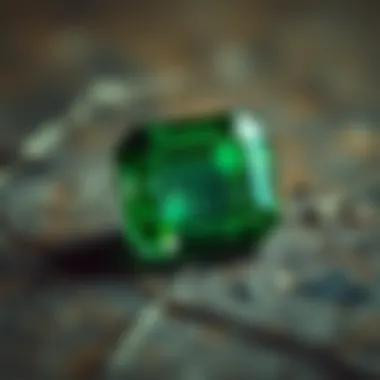
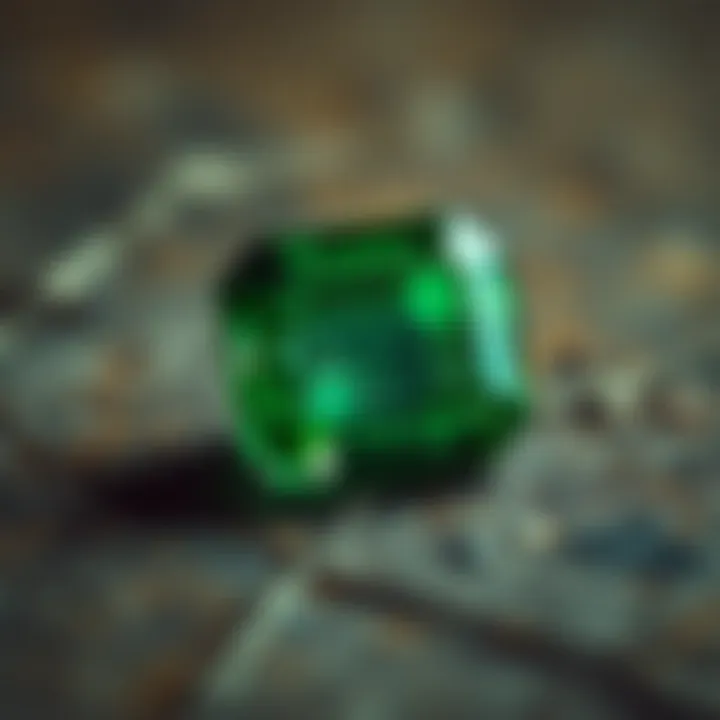
Intro
Gemstones have captivated human imagination for centuries. Their allure is undeniable, ranging from the deep blue of sapphires to the fiery red of rubies. Understanding gemstones goes beyond mere aesthetics; it encompasses history, geology, and even culture. This guide will take you on a journey through the rich tapestry of gemstones, presenting a curated visual collection alongside insights that cater to both the budding enthusiast and the seasoned gem collector.
History and Origins
Overview of Collectibles, Rocks, and Fossils
Gemstones are not just pretty rocks; they are a testament to Earth’s geological history. Each gemstone formation is a story aged over thousands, if not millions, of years. For instance, diamonds are formed under conditions of extreme heat and pressure deep within the Earth’s mantle. Over time, volcanic eruptions bring them closer to the surface, where they can be discovered.
Historical Significance and Cultural Impact
Throughout history, gemstones have held symbolic and mystical meanings. Ancient civilizations revered these natural treasures, embedding them in their cultures and beliefs. The Egyptians, for instance, adorned their tombs with lapis lazuli, believing it offered protection in the afterlife. In contrast, during the Middle Ages, sapphires were equated with divine favor, and bishops often wore them.
"Gemstones have not only served as adornments but have also functioned as talismans throughout history, with each culture attributing unique qualities to different stones."
Identification and Classification
Guide to Identifying Rocks and Fossils
Identifying gemstones can become an absorbing hobby. Each stone has its own unique characteristics. Here are some tips:
- Color: While it’s the most noticeable feature, color can vary widely even within the same gemstone type.
- Hardness: The Mohs scale helps determine scratch resistance. For example, diamond is a 10, while talc is a 1.
- Luster: Some stones, like opal, display a brilliant play of colors while others may appear more subdued.
Common Types and Variations
Gemstones come in a myriad of varieties, with each showcasing unique traits. Here are a few notable types:
- Quartz: Clear quartz and amethyst are popular variants.
- Emerald: Known for its lush green color, this stone is often included with minerals that can affect its clarity.
- Topaz: This gemstone flaunts a spectrum of colors, with the blue variety being particularly sought after.
In summary, the study of gemstones is a rewarding pursuit. They are more than a mere collection of stones; they are a bridge connecting us to the Earth’s history and human culture. The deeper one delves into their origins and qualities, the more enriching the experience becomes.
Foreword to Gemstones
Gemstones have captivated humanity for centuries. Whether they sparkle on fingers, adorn the walls of temples, or lie hidden within the Earth, their luster contributes immensely to art, culture, and even belief systems. As we delve into the world of gemstones, it’s crucial to understand their significance beyond aesthetic appeal. This guide isn’t just about appreciating beauty; it’s also an exploration of origins, classifications, and the stories behind each gem.
The importance of this section lies in the foundation it sets for the reader. Recognizing what gemstones are, how they fit into our culture, and the categories they belong to is essential for anyone—whether a novice or an experienced collector. This initial grasp helps frame each gemstone’s value and meaning, creating a connection between the earth and the individuals who admire these natural wonders.
Definition and Classification
Gemstones are typically defined as naturally occurring minerals that can be cut and polished to create jewelry and other decorative items. They generally possess qualities such as beauty, rarity, and durability that elevate them from mere rocks to treasured items. Classifying gemstones can take many approaches, including:
- Mineralogical classification: Grouping stones based on their chemical composition and crystal structure. For example, quartz is a common mineral, while diamonds fall under the category of carbon crystals.
- Gem-quality classification: This differentiates between precious and semi-precious stones, generally dependent on market demand.
- Synthetic vs. natural: Recognizing whether a stone is made in a lab or formed naturally over time.
Understanding these classifications can empower collectors. Knowing the difference between, say, a natural emerald and a synthetic one could impact purchasing decisions and future valuations. This differentiation helps collectors navigate the complex market landscape effectively.
Cultural Significance
Across various cultures, gemstones hold deep-rooted significance. They are often embedded in myths, rituals, and art forms, conveying messages that transcend generations. For instance, the ancient Egyptians revered lapis lazuli, using it in burial regalia to signify wealth and the divine. In contrast, saffires have been associated with wisdom and noble virtues in cultures around the globe.
Furthermore, gemstones are often tied to astrology and belief systems, with different stones corresponding to specific zodiac signs. This influence can impact not just jewelry choices but also an individual’s personal narrative and identity—shaping perceptions around luck, protection, and strength.
"Gemstones are not just objects of beauty; they are repositories of history, culture, and human emotion."
Understanding the cultural context behind these stones enriches the collector's experience and fosters a deeper appreciation of each piece. As we move through this guide, consider how these narratives and classifications intertwine to cultivate a holistic understanding of gemstones.
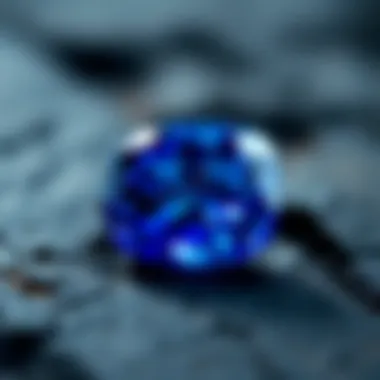
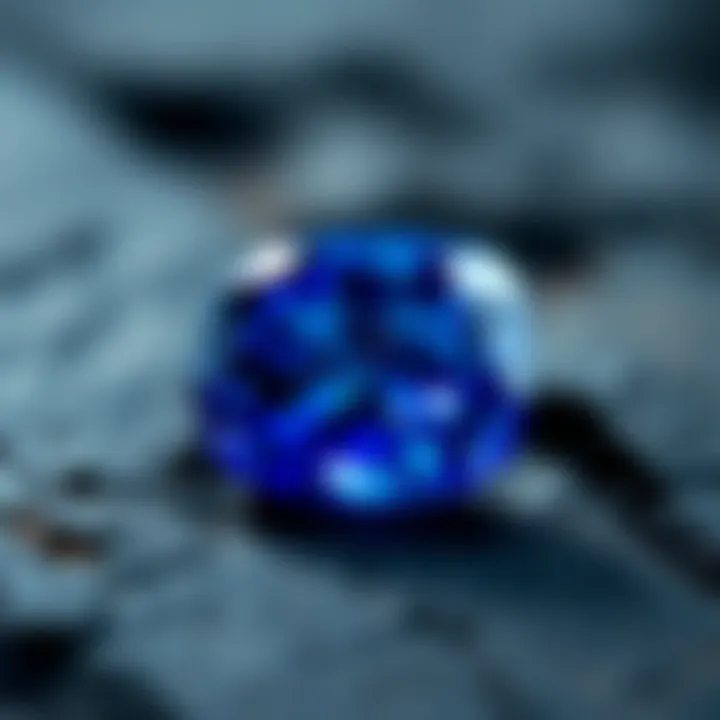
Understanding Gemstone Varieties
The exploration of gemstone varieties opens the door to a deeper understanding of these captivating Earth-born treasures. Recognizing the different kinds of gemstones equips enthusiasts and collectors with invaluable knowledge for identification, valuation, and appreciation. This section delves into the crucial distinctions between categories, the implications of these categories for collectors, and how they shape perceptions in the market.
Precious versus Semi-Precious
There’s a lot more than meets the eye when it comes to gemstones, particularly in the framing of ‘precious’ against ‘semi-precious’. Traditionally, precious gemstones include diamonds, rubies, sapphires, and emeralds. The allure and price tag of these stones often stem from their historical significance and rarity. For example, a well-cut diamond can fetch astronomical prices due to its karat weight, clarity, and color.
In contrast, semi-precious stones, like amethyst, turquoise, or garnet, are often labeled as such because they don’t carry the same price heft. However, it is important to note that this classification does not reflect the beauty or the unique characteristics of the stones. Many semi-precious gemstones command their own legacies and come with substantial perks, including a broader range of colors, accessibility, and functionality in jewelry design.
This classification can influence:
- Market Value: Precious stones can lead to higher investment value, while semi-precious ones offer more affordable options for collectors.
- Cultural Significance: The history tied to certain stones impacts their desirability, not just as ornaments but as cultural artifacts.
- Availability: Semi-precious stones often have a higher availability for aficionados
A basic grasp of which gemstones fall under each category can guide decisions related to buying, selling, or simply appreciating the vast array of choices. It's wise to remember that the charm of a stone lies beyond its label.
Natural, Synthetic, and Imitation Gemstones
The lines between natural, synthetic, and imitation gemstones are often blurred in the gem collecting world. Understanding these distinctions can save collectors from being misled and make informed purchases.
- Natural Gemstones: These are stones that come directly from the Earth, shaped over millennia by natural processes. Every inclusion, flaw, or imperfection tells a story, adding to the stone’s individual character and worth. For instance, a natural sapphire might boast unique markings, making it one-of-a-kind.
- Synthetic Gemstones: Created in laboratories using methods that replicate natural processes, synthetic gems possess the same physical, chemical, and optical properties as their natural counterparts. They often come at a lower price point and can be more ethically sourced. However, some collectors prefer natural stones for their historical and geological significance.
- Imitation Gemstones: These are not true gemstones at all but materials designed to mimic the appearance of a gemstone. Common examples include glass or plastic. While they may have visual appeal, their intrinsic value is practically nonexistent. Collectors should be cautious in dealing with imitations, particularly when purchasing vintage or high-end jewelry.
Each category introduces various considerations—from investment perspectives to emotional resonances tied to the stone.
Understanding these differences not only prevents deception but also enriches the collector's journey through the awe-inspiring world of gemstones.
By grasping these classifications, enthusiasts can navigate the gemstone landscape more adeptly. Whether one is investing in a luxurious diamond or appreciating the beauty of a synthetic stone, each piece has its own narrative and significance that merits recognition.
A Visual Catalog of Gemstones
A visual catalog of gemstones plays a crucial role in connecting the reader with the beauty and intricacies of these natural wonders. It serves as more than just a display of colors and cuts—it acts as a storytelling medium. By presenting images alongside descriptive text, the reader can appreciate not only the aesthetics but also the underlying significance of each gemstone. When someone sees a photo of a deep red ruby or a brilliant diamond, it’s as if a story unfolds, merging their visual experience with history and lore.
Having a visual catalog aids collectors, both novice and veteran, in identifying various gemstones. There's a strong link between visuals and memory retention; images help encapsulate unique characteristics that words alone might struggle to convey. The myriad shades of a gemstone, the way it catches the light, or the subtle imperfections are elements that are only truly appreciated through visuals. This enables enthusiasts to differentiate between authentic stones and imitations, an increasingly relevant skill in today’s marketplace.
Furthermore, a visual approach empowers individuals to grasp the wide array of varieties available. Not each gemstone is suited to every collector’s desire or investment strategy. By flipping through a well-curated catalog, potential buyers can better understand what aligns with their aesthetic preferences or investment goals.
In this section, we’ll delve into the specific gemstones that define the world of collecting. Each one has its own charm and allure, standing out in terms of origin, rarity, and value. Let’s explore the unique attributes that make them so special.
Diamond: Beauty and Brilliance
Diamonds, often dubbed the ultimate expression of luxury, have captured human fascination for centuries. Their stunning refractive qualities lead to a brilliance that most other stones can't match. While popular for engagement rings, the allure of diamonds extends behind mere aesthetics; they symbolize strength and endurance. You might see a champagne diamond, which showcases hues from light brown to golden yellows, adding a twist to traditional clear diamonds.
Rubies: The Royal Gem
Next comes the ruby, recognized universally as a jewel of royalty. The deep red hue, sometimes bordering on purplish, invokes feelings of passion and vitality. Historically, rubies were believed to hold protective powers and bring good fortune. The intensity of their color is dictated by chromium content, with the finest examples hailing from Burma. Collectors often seek out untreated rubies, as these instances of natural beauty are incredibly rare.
Emeralds: The Green Wonder
Emeralds, the lush green paragons of the gemstone world, hold sway over hearts and imaginations alike. This vibrant gemstone has been treasured since ancient times, associated with rebirth and love. Their rich color can fluctuate based on the geographic origin; for instance, Colombian emeralds are often revered for their unparalleled hue. The presence of inclusions, known as "jardin," can actually enhance their character, making them even more sought-after in some circles.
Sapphires: Depth of Blue
While many immediately associate sapphires with the color blue, they actually come in a plethora of shades, from yellows to pinks—yet it’s the deep blue that often captures the most attention. Sapphires are symbols of wisdom and royalty, making them a popular choice for engagement rings. Sri Lankan and Kashmir sapphires are often regarded as the crème de la crème, prized for their vivid hues and quality.
Amethyst: The Purple Crown Jewel
Amethyst, with its regal purple tones, is not just a stunning gem; it also has a fascinating past steeped in mythology. Ancient civilizations believed that amethyst could prevent intoxication, leading to its name derived from the Greek term for “not drunken.” Ranging from pale lavender to deep violet, the quality of this quartz can vary greatly, and it remains an accessible gemstone for many collectors.
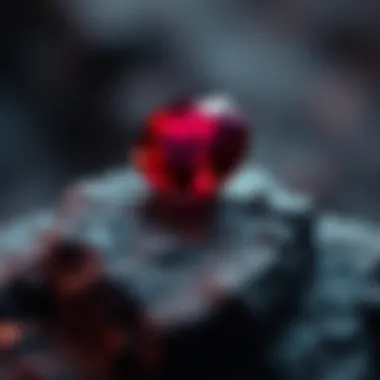

Topaz: A Spectrum of Colors
Topaz is a versatile gemstone known for its diverse color palette. From the classic clear to the captivating imperial topaz with its warm golden tones, this stone dazzles in many forms. Topaz has been favored in jewelry for centuries, also featuring in ancient texts as a symbol of strength. The more rare the color, particularly the colorless variety, the higher its value tends to be.
Opal: The Kaleidoscope Stone
Opals stand out in the gemstone world due to their unique play-of-color phenomenon. Each stone carries a distinct pattern and brimming range of colors. From the striking black opal, which contrasts brilliantly against its dark background, to the lighter white opals, their unpredictability lends them a charm. Ancient cultures revered opals as stones of prophecy and insight, echoing the breathtaking natural patterns they exhibit.
Aquamarine: Tranquility in Blue
The serene blue shades of aquamarine remind wearers of calm seas and tranquil skies. Historically, sailors cherished aquamarine, believing it offered protection during voyages. The stone's clarity and soothing colors make it a favorite for fine jewelry, and gemstone lovers frequently gravitate toward vibrant specimens from Brazil, known for their rich hues and clarity.
Turquoise: Ancient Blue
Turquoise finds its roots deep in history, with its unique blue-green tones making it a favorite across various cultures. Used in countless ancients artifacts, it is known as a protective stone, embodying vitality and healing. The quality can widely vary based on where it’s mined; the copper content in the stone is what dictates its bold color.
Garnet: The Versatile Gem
Last but not least, garnets offer a versatile range of colors and are often overlooked compared to their more famous counterparts. They symbolize passion and commitment and come in shades that range from deep red to vibrant green. Collectors enjoy garnets not only for their beauty but also for the various types within the garnet family, such as the fiery pyrope or the unique tsavorite.
Through the exploration of these gemstones, we begin to grasp the rich tapestry of their histories and the allure they hold for individuals. Each stone embodies a distinct narrative, inviting those curious about collecting to delve deeper into their unique worlds.
Identifying Gemstones
Understanding how to properly identify gemstones is essential for any collector or enthusiast. Each gemstone exhibits unique characteristics, and discerning these traits can help one appreciate their beauty and value. Knowing how to identify gemstones also ensures that enthusiasts make informed purchases, whether in a retail environment or while dealing with private sales.
Having a solid grasp on gemstone identification minimizes the risk of acquiring fakes or lower-quality stones. This knowledge not only enhances the collector's experience, but it also fosters a deeper understanding of the nuances involved in the world of gemstones.
Physical Properties
Gemstones possess specific physical properties that can aid in their identification. Here are some key attributes to consider:
- Color: This is often the first thing noticed when viewing gemstones. However, color can be misleading due to the presence of impurities or variations in light. For instance, sapphires can range from deep blue to pastel shades, whilst rubies display vibrant red colors.
- Hardness: The Mohs scale of hardness ranks minerals on a scale from 1 to 10, providing a basic understanding of how resistant a gemstone is to scratching. For example, diamonds are a perfect 10, while talc ranks a mere 1.
- Luster: This term refers to how light interacts with a gemstone's surface. Some stones boast a vitreous (glass-like) luster, while others may appear more matte or silky. Opals, for example, have a unique play of color, adding to their visual allure.
- Specific Gravity: This measurement expresses the density of a gemstone relative to water. It varies across different types of gemstones and is often used in identification. For those who want accurate measurements, this can be determined by using a balance with a hydrostatic weighing technique.
"Understanding physical properties is like unveiling the story of a gemstone—it speaks volumes about its origins and journey."
- Clarity: Examining a gemstone for internal inclusions or external blemishes can provide insight into its quality. Higher-end gemstones typically have few inclusions and can exhibit clearer brilliance.
With these properties in mind, collectors are better equipped to differentiate between genuine stones and imitations.
Gemstone Testing Techniques
Once the physical properties have been observed, several testing techniques can further confirm gemstone identity:
- Refractive Index Testing: This involves measuring how light bends as it passes through a gemstone. Different types of stones have varying refractive indices, which can help in pinpointing their identity.
- Spectroscopy: Utilizing spectroscopy, one can measure light absorption patterns within a gemstone. Each stone has a unique absorption spectrum, making it useful for identification.
- UV Light Examination: When exposed to ultraviolet light, many gemstones will exhibit a fluorescence that can aid in identification. For instance, some diamonds display a blue fluorescence, while certain minerals might glow vividly under UV rays.
- Microscopy: Using a jeweler's loupe or microscope enables a closer inspection of inclusions, growth patterns, and other internal features. This thorough examination can differentiate between natural stones and synthetics, which often have unique characteristics.
- Hardness Testing: Performing scratch tests can clarify a gemstone's hardness and assist in comparison with known standards, fulfilling one more aspect of the identification process.
By employing these techniques, one can advance their knowledge and skills in identifying gemstones, ensuring that collections remain authentic and valuable.
Caring for Gemstones
Caring for gemstones is as crucial as selecting the right one. These natural wonders, while durable, necessitate attention and upkeep to maintain their luster and structural integrity. Each stone comes with its own set of characteristics and needs, thus understanding how to care for them ensures that both aesthetic value and potential investment remain intact. For rock and fossil collectors, knowing the ropes of gemstone care fosters a deeper appreciation for these earthly treasures.
Cleaning and Maintenance
Keeping gemstones clean doesn't merely enhance their visual appeal; it also prevents dirt and grime from marauding their surfaces. Over time, oils from skin, dust, or even residue from cosmetics can dull the sparkle of a stone. Here are some straightforward and effective methods to keep your gemstones shining bright:
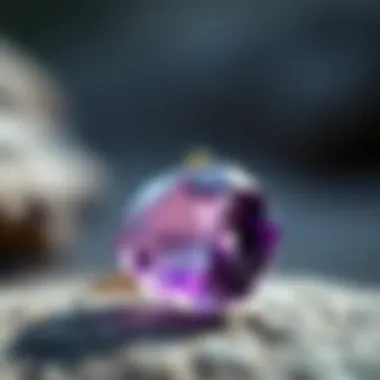
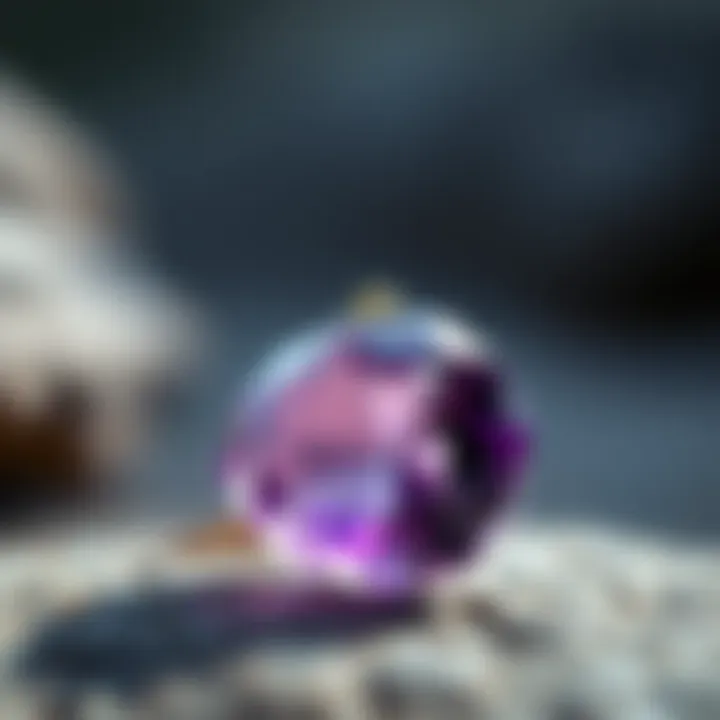
- Use Mild Soap: A mix of warm soapy water usually does the trick. Avoid harsh chemicals which might cause irreversible damage.
- Soft Brushes: A gentle brush can help reach crevices and remove stubborn debris. Old toothbrushes work perfectly, provided they’re soft.
- Rinse Thoroughly: Ensure all soap is washed away, as any remnants can attract dirt quickly.
"A little bit of regular maintenance can save you headache down the line. Don't let dirt be the thief of your gemstone’s beauty!"
Certain stones may require specific considerations. For instance, pearls and opals should never be soaked, as water can penetrate their structures and cause damage. Instead, gently wipe them with a damp cloth. Additionally, remember that ultrasonic cleaners are a no-go for most gemstones. Trusting the wrong equipment with your precious stones could lead to scratches or fractures.
Storage Solutions
The manner in which gemstones are stored can greatly influence their condition over time. A well-thought-out storage solution protects against scratches, chips, and other environmental factors detrimental to a stone’s longevity. Here are some general guidelines for smart storage:
- Separate Storage: Each gemstone should have its own space. Storing them in separate soft pouches or compartments avoids any chances of scratching.
- Avoid Sunlight: Ultraviolet rays can fade colors, especially for those vibrant colored stones like amethyst or topaz. Keep them away from direct sunlight.
- Climate Control: Humidity can be as harmful as heat. Consider using silica gel packs in storage containers to absorb moisture. This is particularly helpful for porous stones.
When displaying gemstones, opt for glass cases that limit dust while allowing visibility. For collectors who cherish both beauty and care, creating a display space that’s not only functional but attractive can add another layer of appreciation.
Having knowledge on cleaning and storage enhances the relationship collectors have with their gemstones, ensuring they remain valued pieces for years to come. Investing time in their care will, in turn, yield a lifetime of enjoyment.
The Economics of Gemstones
The realm of gemstones intertwines art and commerce in a fascinating dance. Understanding the economics of gemstones is pivotal for collectors and investors alike. Recognizing market trends, valuation methods, and investment opportunities can yield significant benefits. Whether you’re a seasoned collector or just getting your feet wet, these elements provide insight into navigating this complex marketplace.
Market Trends and Valuation
Gemstone valuation is as much an art as it is a science. The market for gemstones fluctuates based on a myriad of factors. Economic conditions, demand, and even cultural influences can sway the prices of stones dramatically. In recent years, the rise of ethical sourcing and sustainability has shifted consumer preferences, impacting the desirability and, consequently, the value of certain gems.
- Rarity: The less available a gemstone, the more it typically commands in price. For instance, the pink diamond has seen a surge in value due to its scarcity.
- Quality: Factors such as clarity, color, and cut play vital roles in a gemstone's market value. A well-cut emerald can eclipse an average one in price by several folds.
- Trends: Fashion trends affect demand. Certain stones may become fashionable in cycles, impacting their value exponentially. For instance, in recent years, the elegance of vintage styles has increased the demand for antique gemstones.
The valuation methodology often includes grading systems used by professionals. Organizations like the Gemological Institute of America (GIA) provide certifications that detail a stone's attributes, making it easier for buyers and sellers to agree on a fair price.
"The true beauty of a gemstone lies not just in its sparkle but in its story and journey to you."
Investing in Gemstones
Investing in gemstones can be a lucrative endeavor if approached thoughtfully. Here are some key considerations:
- Research: Knowledge is power. Understanding the market, learning about different types of gemstones, and tracking their historical pricing are crucial first steps. Knowledge transforms a simple purchase into a strong investment.
- Sourcing: Purchasing gemstones from reputable dealers is critical. Ensure you acquire stones that are ethically sourced and come with documentation. This establishes a layer of trust in your investment.
- Long-term Value: Unlike stocks or bonds, gemstones often hold their value—sometimes even appreciating significantly. Well-chosen gems can serve as both an aesthetic addition to a collection and a strategic asset in a financial portfolio.
- Diverse Collection: Just like diversifying an investment portfolio, consider acquiring a range of gemstones. This could mean including both common stones and more rare finds, helping to balance risk and reward.
Investing in gemstones is not without its risks. Prices can be volatile, and the market can be subjective. However, with thorough research and understanding, savvy buyers can find unique opportunities that can lead to substantial returns down the line.
The Future of Gemstone Collecting
As we stand on the threshold of a new era in gemstone collecting, it's paramount to examine the trajectory of this fascinating hobby. Investors and collectors alike must consider how technological advancements and sustainability practices are transforming the landscape of gemstone acquisition and ownership. It’s not just about beauty; the significance of these elements lays the groundwork for future engagements with gemstones. Understanding the changes in this realm enhances the appreciation and value ascribed to these natural treasures while also reflecting the evolving tastes of collectors.
Technological Advances in Identification
Without a doubt, technology is reshaping how we identify and evaluate gemstones. Traditional methods, like using a loupe or microscope, are still useful, but they are increasingly complemented by modern techniques that enhance accuracy. Instruments such as spectroscopes, which analyze the light spectrum emitted from gemstones, offer deeper insights into their chemical composition and authenticity.
Moreover, advancements in machine learning and AI-driven software are now pivotal in distinguishing between natural and synthetic gems. These tools analyze patterns that the human eye may overlook, making it safer for novices and professionals alike when determining authenticity.
"The future of gemstone identification lies in precise technology, ensuring both integrity and value in each stone."
Let’s not overlook handheld devices that can now perform non-destructive testing right at the point of sale. For collectors, having immediate access to such technology means informed decision-making becomes much less complicated. The confluence of technological implementation and gemstone analysis not only augments credibility but also fosters greater trust among buyers and sellers in the market.
Sustainability in Gem Extraction
As conversations around sustainability are more crucial than ever, the gemstone industry is grappling with the implications of environmentally responsible sourcing. Traditional mining practices have often led to severe ecological implications. However, there is a noticeable shift towards more sustainable mining methods, which many collectors are starting to demand.
One notable trend is the rise of ethically sourced gemstones. Whether from mines employing fair labor practices or through projects that restore ecosystems post-extraction, collectors are becoming increasingly conscious of where and how gemstones are mined. The availability of eco-friendly options not only reflects a collective societal shift towards sustainability but also adds value to the collection.
This creates a unique intersection where buyers feel good about their purchases, knowing they are supporting ethical practices. By opting for sustainable sources, collectors are investing in a future that respects both the beauty of gemstones and the health of our planet.
When considering the future of collectible gemstones, it’s safe to say that embracing technological innovations alongside sustainable practices is crucial. Both elements will enhance the overall integrity of the market, paving the way for responsible and informed gemstone collecting for generations to come.
For further reading on sustainable practices in gemstone mining, visit Sustainable Gemstone Mining - Britannica or check out related discussions on Reddit.



